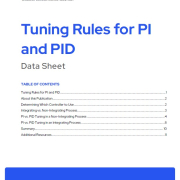Tuning Rules for PI and PID
Tuning Rules for PI and PID
Determining Which Controller to Use
A key challenge in setting up a control system is determining what type of controller to use. The PID controller is generally accepted as the standard for process control, but the PI controller is sometimes a suitable alternative. A PI controller is the equivalent of a PID controller with its D (derivative) term set to zero.
It is important to understand how controllers interact with each different type of process. For details, see Table 1.
Table 1 – How PI and PID Controllers Interact with Different Kinds of Processes
| Controller | Pl Controller | PID Controller |
| Effective for These Processes | Fast processes, such as flow, pressure, and some temperature loops. | Slower processes, such as level and insulated temperature. |
| Tuning Parameters | P = Proportional I= IntegralPl controller is the equivalent of a PID controller with its D (derivative) term set to zero. |
P = Proportional I= Integral D = DerivativeThe derivative term is particularly important for integrating processes, such as level, position, & well-insulated temperature.In general, using a derivative term can significantly increase the speed of the response of a non-integrating process and suppresses overshoot. |
| Response Speed | Response is slower, thus enabling a smooth and accurate PV change. | Response is faster, thus enabling setpoint to be reached more quickly. |
| Overshoot | Overshoot will likely occur. | Reduced or no overshoot. |



